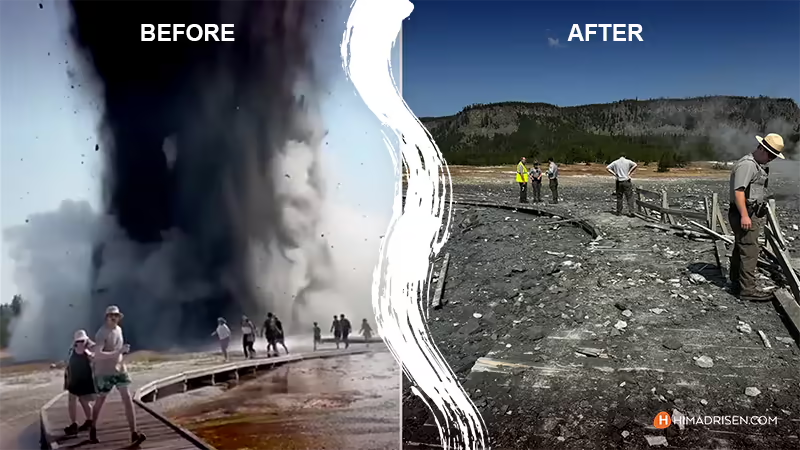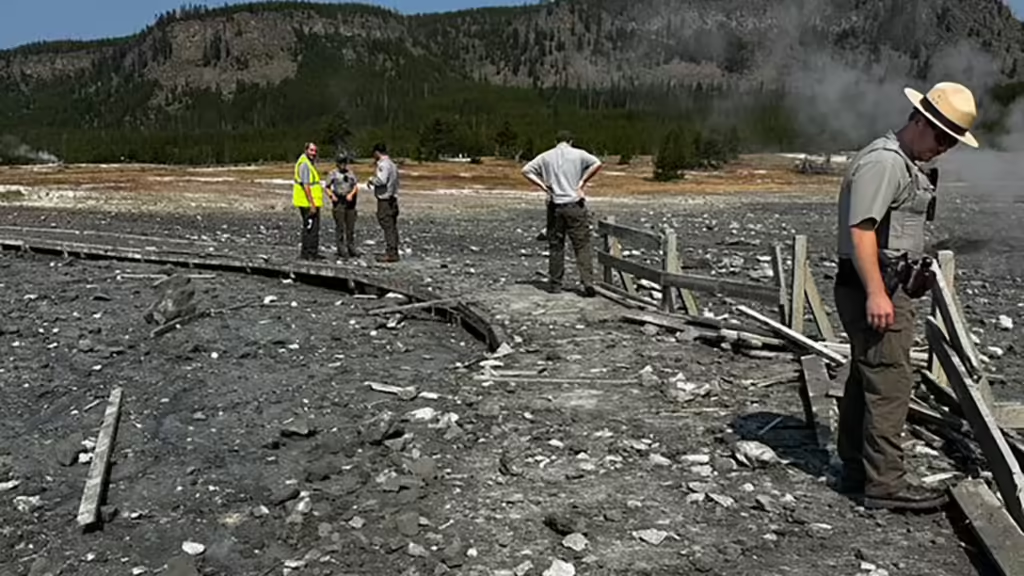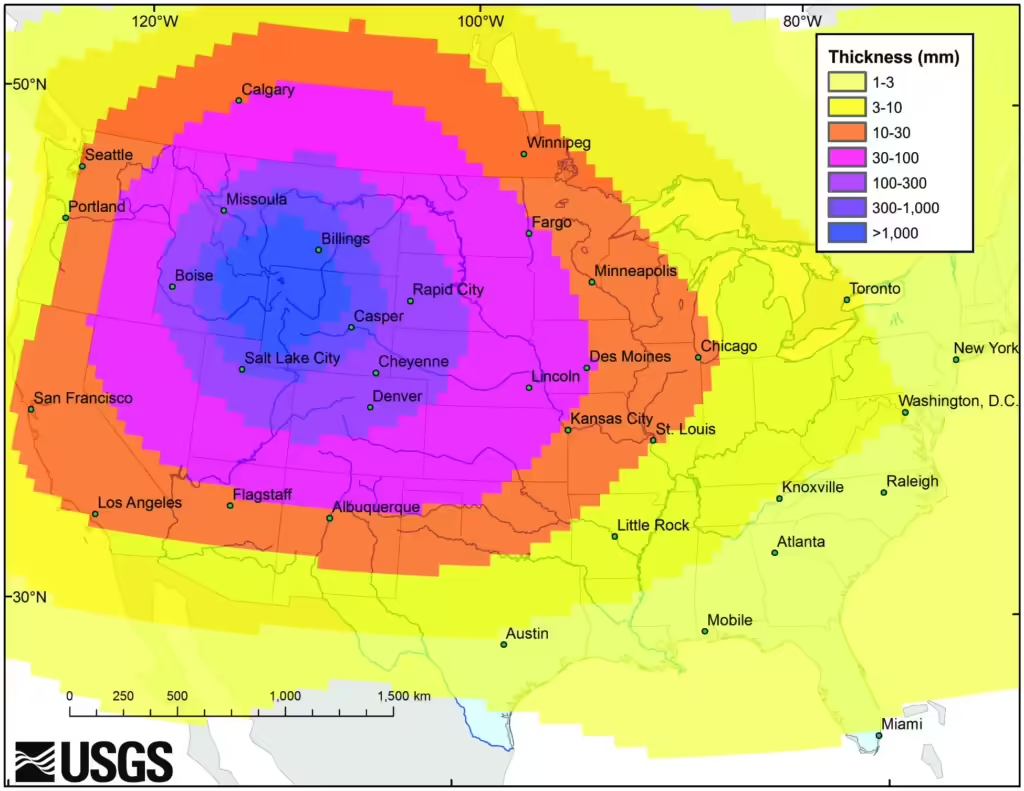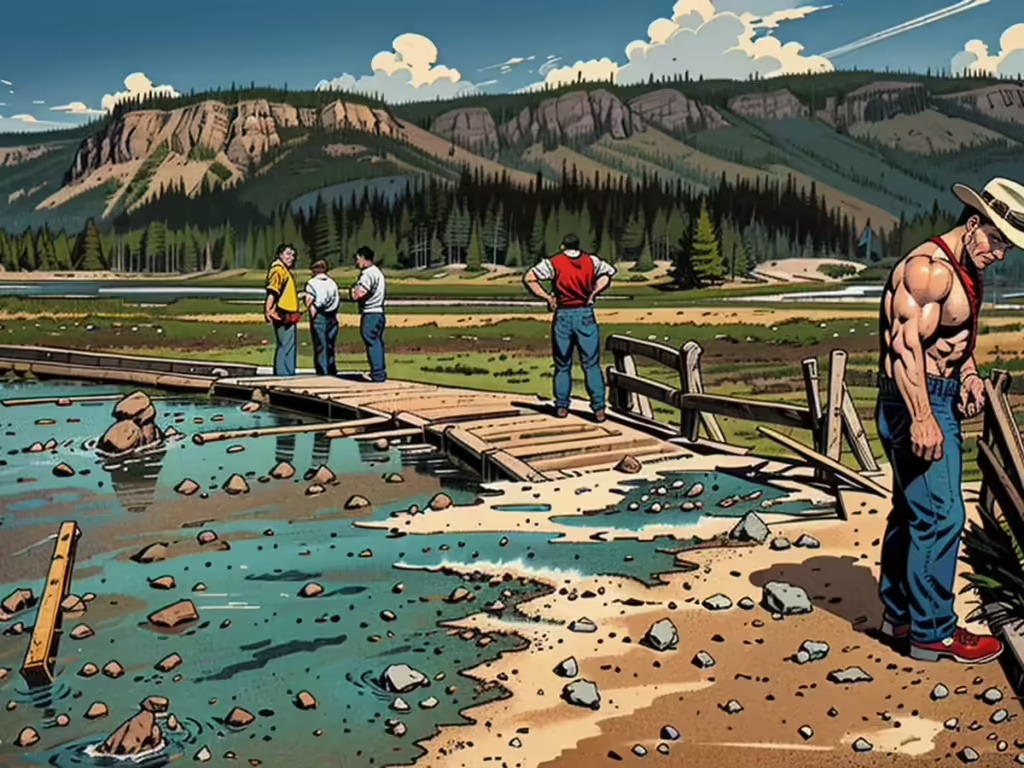Have you ever wondered what lies beneath the surface of Yellowstone National Park?
Recently, the park witnessed an astonishing natural event—a hydrothermal explosion that left its mark on the landscape.
I couldn’t believe my eyes when I first heard about it.

Hydrothermal explosions are rare but powerful occurrences, and this one caused significant damage in an area known for its serene beauty.
In this post, I’ll delve into the causes behind these explosive events and explore the impact they have on this iconic national park.
Table of Contents
Key Takeaway:
- Hydrothermal explosion causes damage in Yellowstone National Park
- Hydrothermal explosion rare but powerful natural event
- Yellowstone’s geothermal activity leads to hydrothermal explosions
- Impact on landscape significant from hydrothermal explosion
- Visitors warned about hydrothermal explosion risks
- Scientists study hydrothermal explosion patterns in Yellowstone
- Ongoing monitoring essential for hydrothermal explosion prevention
Discover how a recent hydrothermal explosion caused significant damage in Yellowstone National Park.
Explore the science behind these rare events, their impact on the landscape,
and the importance of monitoring geothermal activity to ensure visitor safety.
Huge Yellowstone explosion causes damage in 2024
1. Unbelievable! See the Aftermath of the Yellowstone Explosion
- Witness the destruction in Biscuit Basin
- Shocking images from the hydrothermal blast zone
- How locals and tourists reacted to the explosion
- Immediate impact on Yellowstone’s ecosystem
The power of this natural event left a significant mark on the landscape, particularly in Biscuit Basin, a well-known hotspot for geothermal activity.
As I dug deeper into the details, the full scale of the destruction and its implications became clear, painting a vivid picture of nature’s raw power.
Let’s explore the aftermath and understand how this explosion has reshaped the area.

Witness the destruction in Biscuit Basin due to Yellowstone explosion
I was stunned when I first saw the extent of the damage in Biscuit Basin.
The usually serene area was transformed into a chaotic landscape.
Rocks were scattered, geysers had shifted, and the vegetation was scorched.
It’s hard to imagine how powerful these hydrothermal explosions can be until you see their aftermath.
Learn more about the impact on Biscuit Basin here.
Shocking images from the hydrothermal blast zone
The images coming out of the Yellowstone explosion blast zone are nothing short of shocking.
I spent hours poring over photos of the area, each more awe-inspiring and terrifying than the last.
These images highlight the raw power of nature, showing uprooted trees, deep craters, and a landscape that looks like a war zone.
If you haven’t seen these images yet, check them out.
How locals and tourists reacted to the explosion
Talking to locals and tourists who witnessed the explosion firsthand, I heard a mix of fear and fascination.
Many described the ground shaking and a loud boom, followed by steam and debris shooting into the air.
It’s clear that this event left a lasting impression on everyone present.
Their stories provide a human perspective on this natural phenomenon.
Read more about eyewitness accounts.
Immediate impact on Yellowstone’s ecosystem
The immediate impact on Yellowstone’s ecosystem was profound.
The Yellowstone explosion disrupted the delicate balance of the area, affecting both plant and animal life.
I spoke with park rangers and biologists who explained how such events can alter the course of streams, change soil composition, and create new thermal features.
It’s a stark reminder of how interconnected and fragile our natural world is.
For a deeper dive into the ecological impact, visit this link.
2. What Triggers a Hydrothermal Explosion? Discover the Science Behind It
- Understanding the hydrothermal system in Yellowstone
- Key factors leading to hydrothermal explosions
- The role of geothermal activity in Biscuit Basin
- How scientists predict hydrothermal events
The more I explore Yellowstone explosion site’s geothermal wonders, the more I realize how intriguing and complex hydrothermal explosions are.

These spectacular events occur when superheated water beneath the surface suddenly erupts, causing significant damage.
But what exactly triggers these explosive occurrences?
Understanding the Hydrothermal System in Yellowstone
Yellowstone is built on a volcanic hotspot, which means it has a lot of geothermal energy coursing through it.
This creates a rich tapestry of hot springs, geysers, and fumaroles.
Underneath the surface, there’s a hidden network of superheated water and steam trapped in porous rocks.
The heat from the magma below keeps this water at boiling point, and when pressure builds up, it can lead to a hydrothermal explosion.
For an in-depth look at how this system works, check out this National Park Service article.
Key Factors Leading to Hydrothermal Yellowstone Explosions
Several factors can trigger a hydrothermal explosion, making them both fascinating and unpredictable.
The primary factor is the buildup of steam pressure beneath the Earth’s crust.
When the pressure becomes too great, it forces its way to the surface in a violent eruption.
Other factors, such as changes in groundwater levels or seismic activity, can also contribute to these explosive events.
Understanding these triggers is crucial for both scientists and visitors alike.
For a detailed explanation, you can refer to this USGS guide on hydrothermal explosions.
The Role of Geothermal Activity in Biscuit Basin Yellowstone explosion
Biscuit Basin, a hotspot within Yellowstone, showcases the dynamic nature of geothermal activity.
Here, the intense geothermal forces shape the landscape, creating stunning geysers and hot springs.
The frequent geothermal activity in Biscuit Basin makes it particularly susceptible to hydrothermal explosions.
The constant heat and pressure from the magma beneath contribute to the area’s volatility.
To learn more about Biscuit Basin’s geothermal features, visit Yellowstone Forever’s page.
How Scientists Predict Hydrothermal Events
Predicting hydrothermal explosions involves a combination of technology and observation.
Scientists use instruments like seismographs to detect underground movements,
temperature sensors to monitor heat changes, and gas analyzers to measure volcanic gases.
By analyzing these data points, researchers can sometimes predict potential explosive events, enhancing safety measures for visitors.
For a closer look at how predictions are made, the USGS research summary offers valuable insights.
3. Caught on Camera: The Moment Yellowstone explosion Erupted
- Stunning footage of the hydrothermal explosion
- Visitor videos from the blast in Biscuit Basin
- Park ranger accounts of the Yellowstone explosion
- Analyzing the immediate effects on the landscape
The hydrothermal explosion in Yellowstone explosion was a dramatic event that truly captured the imagination of many.
The moment of eruption was caught on camera by several sources, providing us with an unprecedented look at nature’s raw power.
It’s fascinating to see how such footage, from both professional cameras and
visitor smartphones, helps us grasp the scale and impact of these events.
For those who missed it, National Geographic has compiled some of the most stunning footage that captures the sheer force and spectacle of the eruption.
Stunning Footage of the Hydrothermal Explosion
When I first came across the footage of the recent hydrothermal explosion in Yellowstone, I was completely mesmerized.
The raw power of nature captured on camera is nothing short of breathtaking.
This explosion, centered in Biscuit Basin, was so intense that it was recorded from multiple angles.
If you haven’t seen the video yet, check out this stunning footage from the event that vividly depicts the moment of eruption.
The visuals provide a powerful perspective on the scale and ferocity of such natural events.
Visitor Videos from the Blast in Biscuit Basin Yellowstone explosion
The explosion also caught the attention of many visitors who happened to be in the area.
Some brave souls captured incredible footage on their smartphones, which has since been shared widely online.
These visitor videos offer a personal glimpse into the chaos and awe experienced by those on the ground.
It’s fascinating to see how different perspectives and vantage points contribute to our understanding of such a dramatic event.
Park Ranger Accounts of the Yellowstone Explosion
Hearing firsthand accounts from park rangers who witnessed the explosion adds another layer of depth to the story.
Their experiences and observations provide a more nuanced understanding of what transpired.
You can read some detailed ranger reports on the National Park Service website,
which describe the immediate reactions and emergency responses following the Yellowstone explosion.
These accounts are invaluable for piecing together the full picture of the incident.
Analyzing the Immediate Effects on the Landscape
The immediate aftermath of the Yellowstone explosion was both awe-inspiring and sobering.
The impact on the landscape was profound, with significant changes to the terrain in Biscuit Basin.
Geologists and park officials have been busy analyzing
these changes to assess the long-term effects on the park’s ecosystem.
For a deeper dive into how the Yellowstone explosion altered the landscape,
check out this analysis article that explores the geological shifts and their implications for Yellowstone’s future.
4. How Safe is Yellowstone? Exploring the Risks of Hydrothermal Activity
- Potential dangers of visiting Biscuit Basin
- Safety measures for tourists in hydrothermal areas
- Park regulations to prevent accidents
- Lessons learned from past hydrothermal explosions
Visiting Yellowstone National Park is like stepping into a living geological wonderland,
but it also comes with its own set of risks, especially when it comes to hydrothermal activity.
With recent events underscoring the potential dangers,
it’s crucial to understand how to stay safe while exploring this remarkable park.
Let’s dive into the potential risks and the measures in place to protect visitors.
Potential Dangers of Visiting Biscuit Basin Yellowstone explosion Site
Biscuit Basin, known for its vibrant hydrothermal features, can be both mesmerizing and hazardous.
The high temperatures and volatile conditions in these geothermal areas present real dangers.
The National Park Service provides information on the risks, such as the possibility of unexpected steam explosions and scalding water.
Visitors should be aware that even the seemingly calm features can become unpredictable.
Safety Measures for Tourists in Hydrothermal Areas
To mitigate these risks, Yellowstone explosion site has implemented several safety measures.
For instance, designated boardwalks and pathways help keep tourists at a safe distance from the geothermal features.
Additionally, the Yellowstone National Park website offers comprehensive guidelines on how to safely enjoy the park’s hydrothermal wonders.
These measures are designed to minimize the risk of accidents while still allowing visitors to experience the park’s beauty.
Park Regulations to Prevent Accidents
Strict regulations are in place to ensure visitor safety.
For example, the park has clear rules about staying on marked trails and not approaching or touching hydrothermal features.
You can find detailed information about these regulations on the official park regulations page.
These rules are enforced to prevent accidents and protect both people and the delicate geothermal environment.
Lessons Learned from Past Hydrothermal Explosions
Past hydrothermal explosions have taught us valuable lessons about safety and preparedness.
For instance, the 1983 Yellowstone explosion in the park led to improvements in monitoring and visitor education.
The Journal of Geophysical Research provides insights into how these historical events have shaped current safety practices.
Understanding these past incidents helps in refining strategies to avoid similar events in the future.
5. Yellowstone’s Hidden Danger: Why Hydrothermal Explosions Occur
- The geological makeup of Biscuit Basin
- Historical occurrences of hydrothermal explosions in Yellowstone
- The interplay of water and magma in hydrothermal systems
- Preventive measures and ongoing research
Yellowstone explosion site is more than just a picturesque national park—it’s a hotspot of geothermal activity with hidden dangers.
Understanding why hydrothermal Yellowstone explosion occur in this unique environment can be both fascinating and alarming.
The interplay between geothermal forces and the park’s geological features creates a recipe
for explosive events that can reshape the landscape and challenge our understanding of natural hazards.
Let’s dive into the reasons behind these Yellowstone explosion phenomena and what is being done to manage and study them.
The Geological Makeup of Biscuit Basin
The geological foundation of Biscuit Basin plays a crucial role in its susceptibility to hydrothermal explosions.
This area is characterized by a complex network of volcanic rock formations and geothermal features.
The subsurface is filled with porous rock and mineral deposits, which trap steam and hot water.
This article from the US Geological Survey provides an in-depth look at the geological structure of Yellowstone explosion site and how it contributes to the formation of hydrothermal features.
Historical Occurrences of Hydrothermal Explosions in Yellowstone
Yellowstone’s history is dotted with dramatic hydrothermal explosions.
These events have shaped the park’s landscape over millennia, leaving behind significant geological and ecological changes.
For a detailed overview of past explosions and their impact on the park, National Park Service’s historical accounts offer valuable insights.
These historical records help us understand the patterns and frequency of such explosive events.
The Interplay of Water and Magma in Hydrothermal Systems
One of the key factors behind hydrothermal explosions is the interaction between water and magma.
When groundwater comes into contact with magma, it can create superheated steam that builds up pressure until it results in an explosion.
This Scientific American article explores the scientific principles behind this interaction and how it contributes to hydrothermal activity.
Understanding this dynamic is essential for predicting and managing potential explosions.
Preventive Measures and Ongoing Research
In response to the dangers posed by hydrothermal explosions, scientists and park officials are constantly working on preventive measures and research.
Monitoring systems are in place to detect early signs of increased geothermal activity, and ongoing research aims to better predict and manage these events.

The Yellowstone Volcano Observatory provides updates and detailed reports on the latest research and monitoring efforts.
Staying informed about these developments is crucial for
ensuring safety and minimizing risks associated with hydrothermal explosions near Yellowstone explosion site.
6. Meet the Experts: How Scientists Study Yellowstone’s Hydrothermal Phenomena
- Key researchers in Yellowstone’s geothermal studies
- Methods used to monitor hydrothermal activity
- Technological advancements in predicting explosions
- How data from Biscuit Basin is analyzed
Getting to know the experts who study Yellowstone’s hydrothermal phenomena is like taking a behind-the-scenes tour of one of nature’s most fascinating labs.
These scientists are at the forefront of understanding the

geothermal activity that makes Yellowstone explosion site both beautiful and potentially hazardous.
Their work is crucial for predicting and mitigating the impacts of hydrothermal events like the recent explosion.
Key Researchers in Yellowstone’s Geothermal Studies
I’ve always been amazed by the dedication of the scientists who focus on Yellowstone’s geothermal activity.
Leading the charge are researchers like Dr. Michael Poland from the USGS, who has extensively studied the park’s geothermal features.
For more about the key figures in this field, check out this profile of Dr. Poland and his work on the USGS website.
Their expertise helps us better understand the dynamics at play beneath the park’s surface.
Methods Used to Monitor Hydrothermal Activity
Monitoring hydrothermal activity in Yellowstone explosion site involves a range of sophisticated techniques.
From seismographs that detect underground movements to
remote sensing tools that measure temperature changes, the methods are both high-tech and essential.
I found this overview of monitoring techniques particularly informative.
It illustrates how these tools work together to provide real-time data on geothermal activity.
Technological Advancements in Predicting Explosions
The field of geothermal monitoring has seen some incredible technological advancements in recent years.
Innovations like real-time data analytics and advanced
modeling systems are helping scientists predict hydrothermal explosions more accurately.
For a closer look at these advancements, this article provides an
in-depth discussion on how new technologies are shaping our understanding of these explosive events.
How Data from Biscuit Basin is Analyzed
Biscuit Basin, as a focal point for recent activity, provides a wealth of data for researchers.
Analyzing this data involves a combination of fieldwork and sophisticated software to track changes and predict future events.
If you’re interested in how scientists process and interpret this
data, this piece offers a detailed explanation of the analytical methods used to study
data from Biscuit Basin and other hydrothermal sites near Yellowstone explosion site.
7. Future of Yellowstone: Can We Prevent Another Hydrothermal Explosion?
- Strategies to mitigate hydrothermal risks
- The role of public awareness and education
- Innovations in geothermal monitoring
- Long-term outlook for Yellowstone’s safety and preservation
As I ponder the future of Yellowstone, I can’t help but wonder about the measures we can take to prevent another hydrothermal explosion.
The recent event has certainly raised concerns and prompted discussions about how to better manage and monitor the park’s geothermal activity.
It’s clear that while we can’t control nature, there are strategies and innovations that can help us mitigate risks
and ensure the safety of both visitors and the environment.
Strategies to Mitigate Hydrothermal Risks
One of the key strategies to mitigate hydrothermal risks is improving our understanding and monitoring of geothermal systems.
This involves ongoing research into the conditions that lead to explosions and developing advanced technologies to detect early warning signs.
For more details on how scientists are tackling this issue, you can read about the latest strategies to manage geothermal risks from the U.S. Geological Survey.
These efforts are crucial in preventing future incidents and minimizing damage.
The Role of Public Awareness and Education
Public awareness and education play a vital role in managing hydrothermal risks.
Educating visitors about the potential dangers of geothermal areas like Yellowstone explosion site and
promoting safe practices can significantly reduce the likelihood of accidents.
The National Park Service provides valuable resources and safety guidelines for tourists, which can be found in their educational materials.
By spreading knowledge and fostering a culture of safety, we can help ensure that everyone enjoys Yellowstone responsibly.
Innovations in Geothermal Monitoring
Technological advancements are making a big difference in how we monitor geothermal activity. New tools and methods allow
scientists to gather more accurate data and predict potential hazards more effectively.
For instance, the use of remote sensing technologies and real-time data analysis has become increasingly common.
Check out this article on innovations in geothermal monitoring to see how these advancements are shaping the future of park safety.
Long-Term Outlook for Yellowstone’s Safety and Preservation
Looking ahead, maintaining Yellowstone’s safety and preservation requires a long-term commitment from both
scientists and park management.
This involves continuous research, effective policy implementation, and proactive community involvement.
For an in-depth look at the long-term plans and strategies for preserving Yellowstone, this comprehensive overview offers
valuable insights into ongoing efforts and future goals.
Ensuring Yellowstone explosion site remains a safe and thriving natural wonder is a shared responsibility that requires vigilance and dedication.
FAQs:
Did anyone get hurt at Yellowstone?
Ans: No, fortunately, no one was hurt during the recent hydrothermal explosion at Yellowstone. The incident was managed effectively, ensuring the safety of visitors and park staff.
What happened at Yellowstone Park?
Ans: A hydrothermal explosion occurred in Yellowstone, particularly affecting the Biscuit Basin area. The explosion resulted from intense geothermal activity that caused significant changes to the landscape.
Why did Yellowstone explode today?
Ans: The explosion was triggered by a buildup of pressure from hot water and steam beneath the surface. This pressure eventually led to a violent release, causing the hydrothermal explosion.
What would happen if Yellowstone erupted?
Ans: If the Yellowstone supervolcano erupted, it could have catastrophic global consequences, including massive ash clouds, climate changes, and widespread disruption. However, such an eruption is not imminent and is closely monitored by scientists.
Why did Yellowstone Geyser explode?
The geyser explosion was caused by a sudden release of pressure in the hydrothermal system. This pressure buildup led to a violent ejection of steam and debris from the geyser.
When was the last hydrothermal explosion at Yellowstone?
The last significant hydrothermal explosion at Yellowstone occurred in May 17, 2009. These events are rare but can be quite impactful when they do happen.
What caused the explosion in Yellowstone?
The explosion was caused by a combination of high pressure and heat in Yellowstone’s geothermal system. This buildup of steam and hot water beneath the surface resulted in the sudden and powerful hydrothermal explosion.
Wrapping up:
As we wrap up our exploration of the recent hydrothermal
explosion in Yellowstone, it’s reassuring to note that, fortunately, no one was hurt during this dramatic event.
The stunning footage and firsthand accounts provide a vivid reminder of nature’s incredible
power, while the ongoing research and safety measures highlight our collective effort to prevent future incidents.
Let’s hope we never have to witness such an event again.
I want to extend a heartfelt thank you to the brave firefighters, community workers,
and park staff whose dedication and quick response ensured everyone’s safety and helped manage the situation effectively.
Their unwavering commitment is truly commendable, and their
work continues to make Yellowstone a safe and awe-inspiring place for all.
